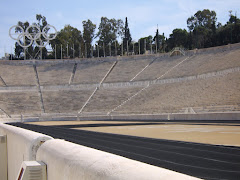On its pages readers find nearly 120 illustrations Olderman created in the author's decades-spanning sports journalism career that started when the student newspaper at his undergrad alma matter Mizzou published one of his cartoons.
He went on to draw thousands of works of art inspired by countless experiences in the sports box on assignment from newspapers and the wire service for which he eventually managed sports coverage.
Readers learn Olderman's aspirations to write and illustrate sports began during his youth when his father brought home newspapers filled with sports cartoons in the days before photography and technology came to dominate athletic coverage.
I was intrigued by "The Draw of Sports" since it seemed if Olderman wrote and created images from the 1940s to recent years, he probably met an Olympian or two with some stories to share.
Jesse Owens appears in the cover art for this new book, and in the text describing the Owens portrait that Olderman sketched for a Games-centric magazine spread, readers learn Olderman perhaps also drew Olympians Jim Thorpe, Paavo Nurmi, Charley Paddock, Harrison Dillard and Bob Mathias on a special assignment tied to the 1952 Games.
The format for "The Draw of Sport" is consistent: Even pages feature a few paragraphs the author scribed from his memories of athlete encounters and interviews, with a matching cartoon on the facing odd page. Owens appears in the middle of Olderman's A to Z list book-ended by Atlanta Braves home run king Hank Aaron and 1932 Olympian Babe Zaharias.
"[In 1954] I actually met Jesse Owens at a luncheon at Toots Shor's on 52nd Street in Manhattan, the favorite sports hangout in the city," wrote Olderman on his Owens descriptor. "[He] was doing motivational speaking by then after varied ways trying to capitalize on his Olympic glory. I don't remember what company he was plugging, but do recall the staccato cadence of his speech."
Olderman described similar "I was in the room with ..." or "when I spoke to ..." Olympian encounters that pop up a few times in "The Draw of Sport" on narrative/illustration pairs for Muhammad Ali, Jean-Claude Killy, Jim Thorpe and Zaharias.
Olympic basketball's Ann Meyer (1976 -- appearing in a spread featuring her pro baseball husband Don Drysdale), Bill Russell (1956 in Melbourne) as well as 1960 team alternate John Havlicek also made the cut.
The Games appear in a handful of other narratives, but mostly to provide context on Olderman's reporting assignments rather than specific Olympians.
Kareem Abdul-Jabar, for instance, appears in "The Draw of Sport" for his basketball feats, but Olderman's illustration of the black boycott of the 1968 Games -- in which Abdul-Jabar participated before his NBA career -- did not show up on first glance (I found the rings illustration at left on MurrayOlderman.com and, later, on one of the section dividers in the new book).
Piecing together notes from the introduction and a few cartoon descriptions, it seems Olderman perhaps only touched the Games remotely in 1952, 1956 and 1960 but later traveled to the Olympics in 1968, which he described with some detail.
"Let's just say I had an edge on my American colleagues covering the Winter Games at Grenoble, where my focus was on Alpine events and a dashing young Frenchman who was swooping to a covey of gold medals," wrote Olderman of Killy. "[His] English was nil then [and] the interviews were conducted only in French.
"I was fairly fluent and could follow his explanations of navigating through the fog that embraced the slalom and downhill runs ... and passed them along to Jim Murray of the Los Angeles Times, the only other scribe who bothered to come out to the Olympic site."
While Olderman's work and collection are impressive, I was slightly let down that so few five-ringed athletes -- an only two female Olympians -- are in "The Draw of Sport."
With only a handful of Team USA athletes celebrated (and only one French gold medal skier), I was left wondering how Olderman reported on, say, Bruce Jenner in Montreal, or Olga Korbut and Nadia Comenici's gymnastic feats, or any of the legendary performances in Los Angeles 1984 (the only post-1960s Olympiad mentioned by Olderman was a vague reference to seeing Michael Jordan play for The Dream Team in 1992).
But then, by the 1970s fewer newspapers illustrated their sports coverage with hand-drawn art, perhaps explaining, if only indirectly, the absence of these later Olympic heroes.
In his editorial role, Olderman founded the Jim Thorpe Trophy presentation to top professional football players, paying homage to the 1912 Olympian who later excelled in multiple pro sports. The book's Thorpe tribute correctly references part of Thorpe's gold medal feats only to incorrectly state his "medal" (singular) was stripped (Thorpe won then lost then received again posthumously gold medals -- plural -- in decathlon and pentathlon).
But this is a forgivable error for a sports cartoon legend who was approaching his 95th birthday as "The Draw of Sport" was going to press.
I encourage sports fans old and young to get a dose of history through reading this Olderman collection. The cartoons provide a broad roundup of sports feats from the 20th century, and the author's stories bring them to life. A video from his grad school alma matter follows this post for more background on this sports writer and artist.
Images via Fantagraphics and MurrayOlderman.com


















